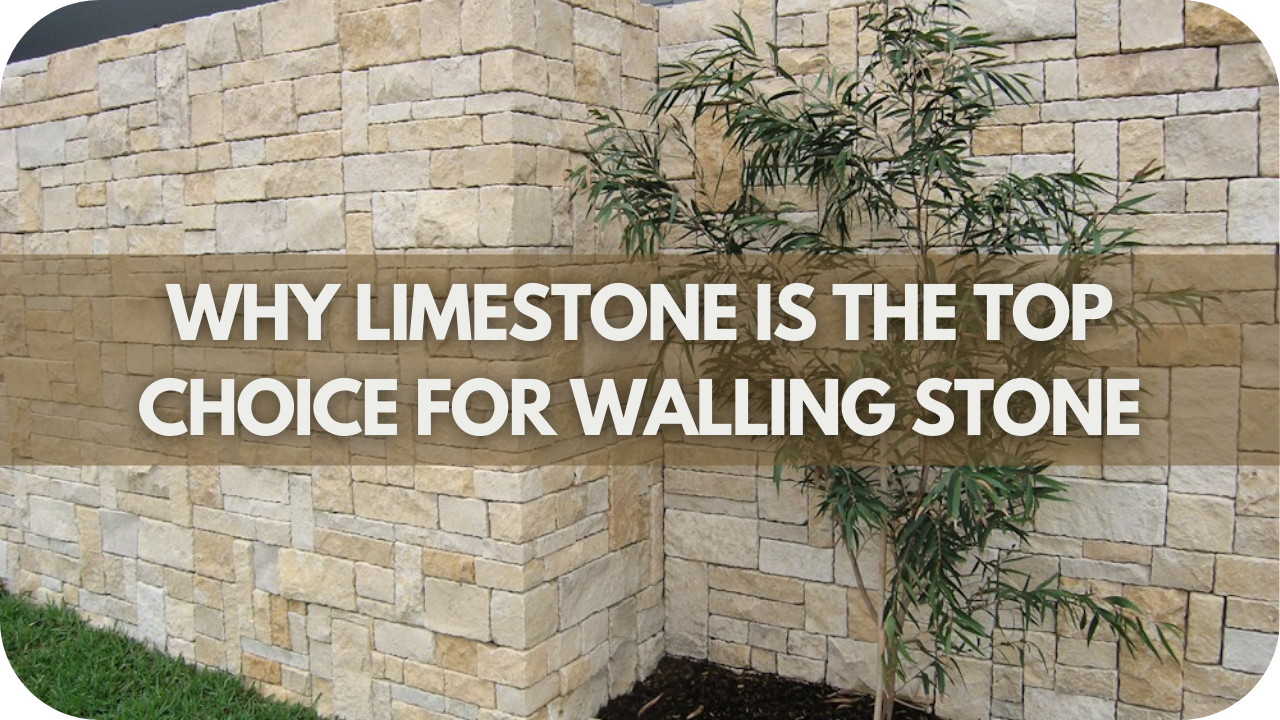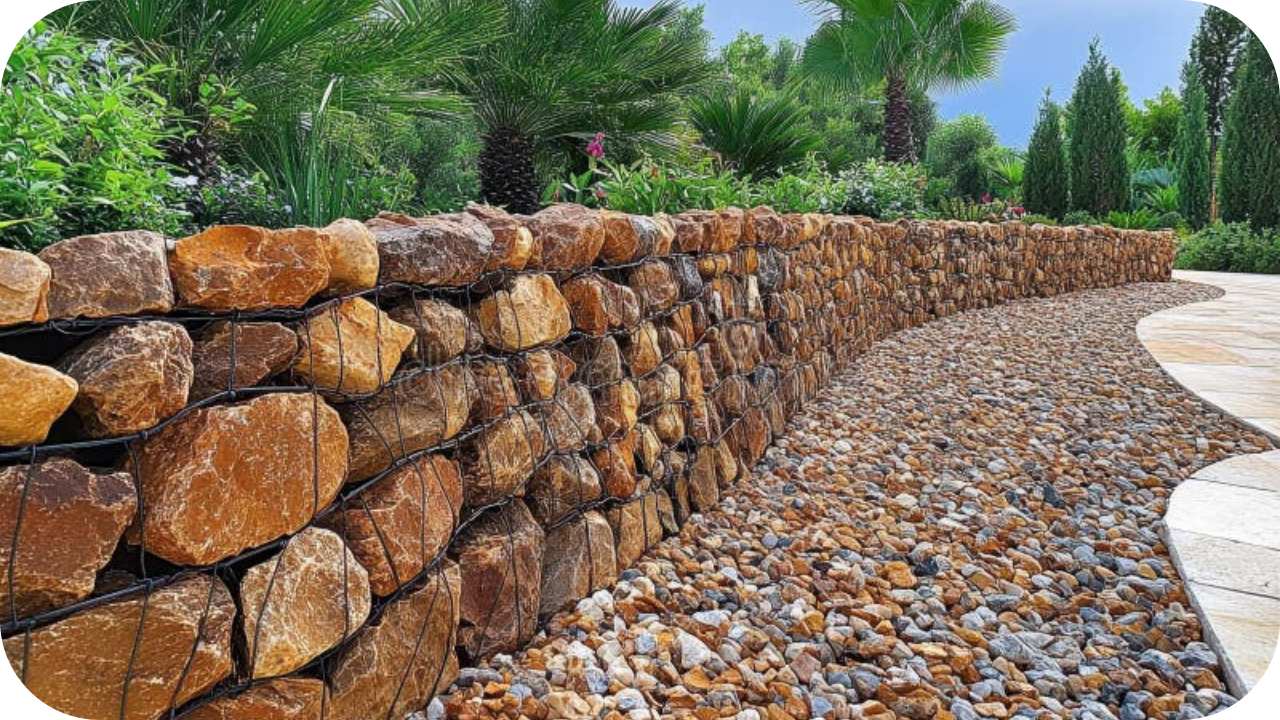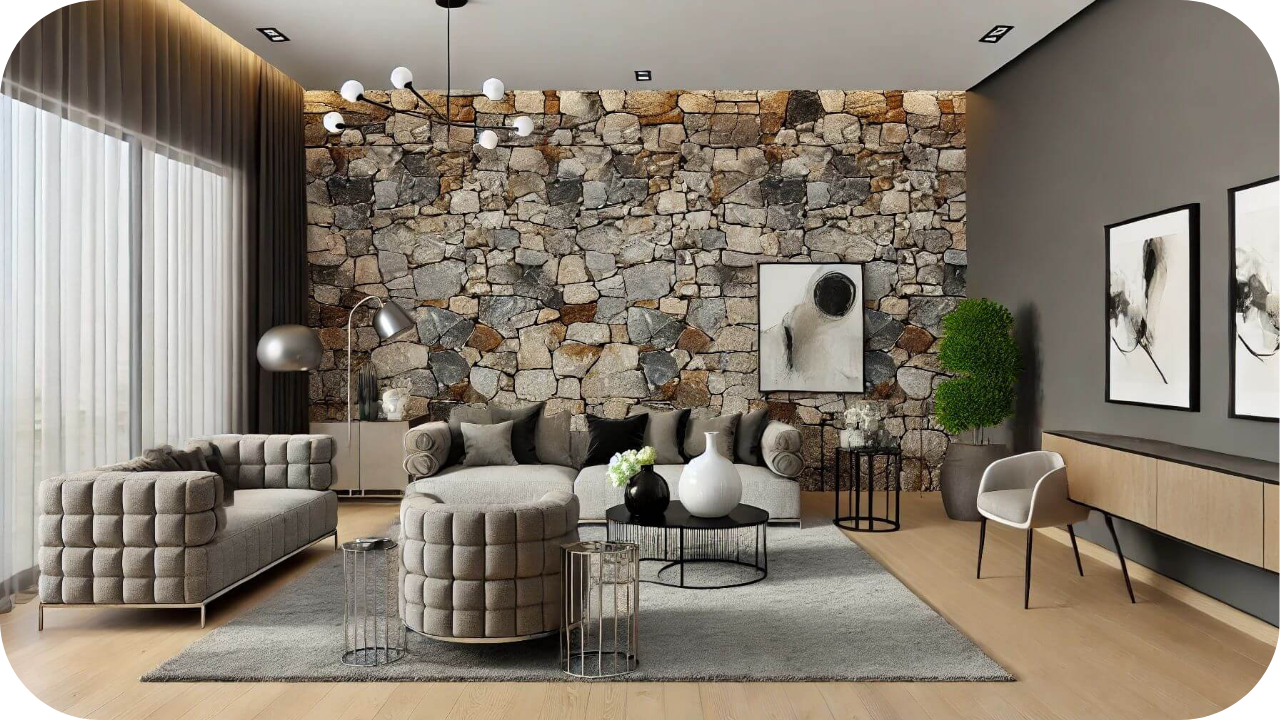
Choosing the right material is crucial for durability, aesthetic appeal, and functionality when constructing walls.
Many options exist, but not all of them offer the same level of benefits and versatility. Traditional materials like brick or concrete may fall short in certain aspects.
Limestone is the top choice for walling stone. It provides a perfect blend of advantages, making it an excellent solution for various walling applications.
Benefits of Using Limestone for Walling
Limestone is a popular choice for walling due to its remarkable combination of durability, aesthetic appeal, and environmental benefits.
This natural stone has been used in construction for centuries, and its enduring qualities continue to make it a preferred material for modern architectural projects.
For a deeper understanding of the various types of limestone and their specific uses, check out our detailed guide on Different Types of Limestone.
Here are some key benefits of using limestone for walling:
1. Durability and Longevity
Limestone stands out for its exceptional durability and longevity when considering walling stone. Resilient to the ravages of time, this stone withstands harsh weather conditions, making it ideal for various climates.
One of its most impressive features is its ability to resist cracking and erosion, which ensures that it maintains its aesthetic appeal and structural integrity for decades.
Have you ever wondered why many ancient structures still stand strong today? The secret often lies in the use of limestone. Unlike softer stones, limestone’s hardness provides a robust barrier against physical and environmental damage. The stone’s natural ability to age gracefully allows it to develop a unique patina, adding to its charm as it matures.
In terms of maintenance, limestone requires minimal upkeep, further enhancing its appeal as a long-term investment. Due to its consistent performance, limestone is preferred for historic restoration and new constructions.
2. Aesthetic Appeal
Limestone offers a timeless aesthetic that can enhance any architectural design. Characterised by its warm, natural tones, the stone provides a versatile backdrop that complements a wide range of styles, from rustic to modern.
What makes limestone truly special is its ability to blend seamlessly with traditional and contemporary elements. Each piece of limestone features unique veining and colour variations, contributing to its distinctive appearance. Elegance is inherent in its smooth texture and subtle sheen, making it a favourite among designers and homeowners alike.
Unlike synthetic materials, limestone exudes authenticity and character, often becoming a focal point in interior and exterior applications. Furthermore, the stone’s ability to age gracefully allows it to develop a rich patina over time, enhancing its visual appeal.
Limestone adds beauty and a sense of enduring quality and sophistication when walling. This natural stone’s appeal remains consistently high, ensuring it continues to be a preferred choice for enhancing the aesthetic value of any property.
3. Thermal Efficiency
Limestone excels in thermal efficiency, making it a smart choice for walling stone. Effectively regulating indoor temperatures enhances comfort in both hot and cold climates. Isn’t it impressive how natural materials can offer such practical benefits?
This stone acts as a natural insulator, reducing the need for additional heating or cooling. Due to its thermal mass, limestone absorbs heat during the day and releases it slowly at night, helping to maintain a stable indoor environment.
Compared to many modern materials, it often outperforms energy efficiency. Limestone walls can significantly lower energy costs in regions with extreme temperatures by minimising temperature fluctuations.
Homeowners and builders value this feature, as it contributes to comfort and cost savings. Additionally, the stone’s ability to moderate temperature variations enhances its appeal in sustainable construction.
4. Environmental Sustainability
Limestone is a top choice for those prioritising environmental sustainability in their building projects. Its natural abundance and ease of extraction make it an eco-friendly option compared to many synthetic alternatives.
Have you ever considered how the environmental impact of materials can vary so greatly? Limestone’s production process uses relatively little energy, reducing its carbon footprint. Additionally, this stone is fully recyclable, meaning it can be reused or repurposed at the end of its lifecycle.
Limestone’s long lifespan contributes to its sustainability by decreasing the need for frequent replacements. Furthermore, it supports biodiversity since its quarrying often impacts local ecosystems less than other materials.
The stone’s ability to naturally regulate indoor temperatures aligns with sustainable building practices by improving energy efficiency..
5. Versatility
Limestone’s versatility makes it an exceptional choice for various applications. From grandiose façades to subtle interior accents, this stone easily adapts to different architectural styles. Why does limestone hold such widespread appeal?
Its natural colours and textures seamlessly complement both modern and traditional designs. When considering limestone for walling, its ability to be cut into different shapes and sizes facilitates intricate designs and detailed craftsmanship.
The stone’s adaptability extends beyond mere aesthetics—it performs well in various environments, from urban settings to rural landscapes.
In addition to its visual flexibility, limestone’s durability and ease of maintenance make it suitable for high-traffic areas and quieter spaces. Exterior applications benefit from limestone’s resistance to weathering, while its thermal properties contribute to building energy efficiency.
When landscaping, limestone can be crafted into retaining walls, paving, and garden features, showcasing its functional and decorative potential. Furthermore, limestone’s integration with other materials, such as wood or metal, allows for creative design combinations and contrasts.
Applications of Limestone in Walling
Limestone is a versatile material with extensive applications in residential and commercial walling projects due to its durability, aesthetic appeal, and adaptability.
1. Exterior Cladding
Limestone is an excellent choice for exterior cladding, offering both aesthetic appeal and functional benefits. Why is it so favoured for building façades? The stone’s natural texture and colour provide a timeless, elegant look that can enhance any architectural style.
Limestone’s significant advantage is its resilience to weather conditions; it withstands rain, wind, and UV exposure without compromising its appearance. Its durability ensures that cladding remains intact and attractive over time, reducing the need for frequent repairs or replacements.
Furthermore, limestone’s thermal properties contribute to energy efficiency by providing an additional layer of insulation that helps regulate indoor temperatures.
Installation is straightforward, and the stone can be cut to various sizes to fit different design requirements. The natural variations in limestone’s colour and texture also add a unique character to each project, making every installation distinct.
2. Interior Walling
Limestone is a standout choice for interior walling, blending style and functionality effortlessly. How does it enhance indoor spaces so effectively? The stone’s natural warmth and texture create a sophisticated ambience, making it suitable for contemporary and traditional interiors.
In addition to its aesthetic appeal, limestone offers excellent durability and ease of maintenance. Its ability to withstand wear and tear ensures that walls retain their beauty over time, even in high-traffic areas. Furthermore, limestone’s thermal properties contribute to a comfortable indoor environment by regulating temperature fluctuations.
Each piece of limestone is unique, with distinct veining and colour variations that add character to any room. Installation versatility allows for creative designs, whether used as a feature wall, fireplace surround, or accent trim. The stone’s natural acoustic benefits also help reduce noise levels, enhancing the tranquillity of indoor spaces.
3. Retaining Walls
Limestone is an exceptional choice for constructing retaining walls due to its remarkable strength and versatility. Why is limestone so well-suited for this purpose? The stone’s inherent durability provides the necessary structural support to resist the lateral pressure exerted by soil, making it highly effective at preventing erosion and stabilising slopes.
With its substantial weight and density, limestone offers significant resistance against shifting and settling, ensuring long-lasting stability for retaining structures.
In addition to its structural benefits, limestone adds a touch of elegance to any landscape. The natural hues and textures of the stone create a visually appealing contrast with the surrounding greenery, seamlessly integrating with various garden styles.
Each limestone block features unique colour variations and patterns, which enhance the retaining wall’s aesthetic charm and contribute to its distinctive character.
Furthermore, limestone’s ability to withstand extreme weather conditions ensures that the retaining wall remains reliable and effective throughout the seasons.
4. Garden and Boundary Walls
Limestone is an excellent choice for garden and boundary walls, combining beauty and durability. How does limestone improve these outdoor features? The stone’s natural texture and warm hues add a sophisticated touch to any garden or boundary setting.
Durability is crucial; limestone withstands various weather conditions, maintaining its strength and appearance over time. Boundary walls it offer a robust barrier that ensures privacy and security, making it an ideal choice for safeguarding properties.
Limestone’s aesthetic appeal enhances garden spaces with its classic charm and unique variations in colour and pattern. Its versatility allows it to fit seamlessly into different design styles, from traditional to contemporary, providing flexibility in garden planning.
Limestone’s ability to handle exposure to elements like rain, sun, and frost ensures that garden and boundary walls remain functional and attractive throughout the seasons.
Its substantial weight and structural integrity make it a reliable choice for supporting and stabilising soil in garden applications. Ultimately, choosing limestone for garden and boundary walls boosts the visual appeal of outdoor areas and provides lasting durability and effectiveness.
Commercial Buildings
Limestone is an exceptional material choice for commercial buildings, combining elegance with practical benefits. Why does limestone stand out in commercial construction?
The stone’s natural beauty and sophisticated appearance make it ideal for creating striking facades and prestigious interiors. From sleek modern offices to splendid public buildings, limestone offers design versatility that can elevate any commercial property’s overall aesthetic.
Limestone’s durability is a significant advantage; it can withstand heavy use and environmental stress, ensuring the building maintains its structural integrity over time.
The stone’s resistance to weathering and erosion means it retains its visual appeal despite exposure to various weather conditions, reducing the need for frequent maintenance or replacement.
In addition, limestone’s thermal properties contribute to the building’s energy efficiency by providing natural insulation, which helps regulate indoor temperatures and reduces heating and cooling costs.
Architects and builders appreciate limestone’s adaptability, as it can be used in various finishes and styles to meet specific design requirements. For instance, polished limestone can add a touch of luxury to lobbies and meeting rooms, while honed or textured finishes are suitable for exterior cladding and high-traffic areas.
Tips for Choosing the Right Limestone
Selecting the right limestone for your walling project is crucial to achieving both aesthetic appeal and structural integrity. Here are some essential tips to guide your decision
1. Consider the Colour and Texture
Imagine a wall that not only stands strong but also captivates the eye. Limestone offers precisely that allure with its diverse range of colours and textures. From creamy whites to warm beiges and cool greys, this versatile stone provides an array of hues to complement any architectural style.
Rough-hewn surfaces create a rustic charm, while smooth finishes exude elegance and sophistication. Have you considered how the play of light can transform your limestone wall throughout the day? As sunlight shifts, subtle variations in the stone’s surface come to life, adding depth and character to your structure.
Durability meets aesthetics in limestone, with its natural patterns and fossil inclusions offering unique visual interest. Weathering over time only enhances its beauty, developing a distinctive patina that tells a story of endurance. Whether you’re aiming for a contemporary look or a more traditional feel, limestone’s adaptability shines through.
Architects and homeowners alike appreciate the stone’s ability to blend seamlessly with various design elements.
2. Evaluate Durability
Regarding walling stone, durability is paramount – and limestone stands tall as a champion of longevity. This remarkable material has weathered the ages, with ancient structures like the Great Pyramid of Giza showcasing its enduring strength. But what exactly makes limestone such a resilient choice?
Impressive compressive strength is one of limestone’s key attributes. This natural robustness allows it to bear significant loads without succumbing to cracks or crumbles. Weather resistance further bolsters limestone’s reputation, as it admirably withstands rain, wind, and temperature fluctuations. Have you considered how this translates to lower maintenance costs over time?
Limestone’s durability isn’t just about raw strength. Its natural density helps repel water, reducing the risk of freeze-thaw damage in colder climates. Resistance to salt spray makes it an excellent choice for coastal areas, where other materials might quickly deteriorate.
Over the years, a protective patina develops on limestone, enhancing its durability. This natural process adds character and serves as a shield against environmental factors. Properly sealed and maintained, a limestone wall can last generations with minimal intervention.
While no material is entirely impervious to damage, limestone’s track record speaks volumes. From historic cathedrals to modern homes, its enduring strength continues to impress builders and homeowners alike.
3. Assess Maintenance Requirements
Are you dreading high-maintenance building materials? Limestone offers a refreshing alternative with its minimal upkeep needs. This natural stone’s inherent durability translates to less frequent repairs and interventions, making it a cost-effective choice for the long term.
Regular cleaning is typically required to keep limestone walls looking their best. A simple wash with mild soap and water can remove most dirt and grime, while tougher stains might necessitate a specialised stone cleaner. Have you considered how this ease of maintenance could save you time and money?
Sealing limestone walls is recommended every few years to enhance their resistance to moisture and staining. This process, while necessary, is relatively straightforward and can often be done by property owners themselves.
Over time, limestone may develop a natural patina that many find appealing. Should you prefer to maintain the original appearance, occasional resealing or gentle cleaning can help preserve the stone’s initial look.
When needed, repairs are generally uncomplicated. Damaged stones can be individually replaced without affecting the entire wall, a significant advantage over other walling materials.
Frost damage is rarely a concern for properly installed limestone walls, thanks to the stone’s natural resistance to freeze-thaw cycles. Occasionally, rinsing with fresh water can prevent salt build-up in coastal areas and ensure longevity.
4. Consider Environmental Factors
Are you seeking an eco-friendly walling solution? Limestone emerges as a compelling choice for the environmentally conscious builder or homeowner. This natural stone boasts several green credentials that make it stand out in the construction industry.
Minimal processing is needed to prepare limestone for use, decreasing energy consumption and associated emissions. Have you considered how this could lower your project’s overall environmental impact? The stone’s natural state requires little alteration, reducing the resources needed to make it construction-ready.
Durability plays a crucial role in limestone’s environmental profile. Its long lifespan means fewer replacements over time, conserving resources and reducing waste. When a limestone wall eventually ends, the material can be recycled or repurposed, supporting circular economy principles.
Limestone’s thermal properties contribute to energy efficiency in buildings. Its natural insulating qualities help maintain consistent indoor temperatures, potentially reducing heating and cooling costs.
Biodiversity is another area where limestone shines. Walls built from this material can provide habitats for various plant and insect species, supporting local ecosystems.
Chemical runoff, a concern with some building materials, is minimal with limestone. Its natural composition means it doesn’t leach harmful substances into the surrounding environment.
5. Budget Wisely
Ever heard the saying, “Buy cheap, buy twice?” When it comes to limestone, this rings especially true. While it might be tempting to go for the cheapest option, remember that quality comes at a price. Inferior limestone can crack, fade, or crumble over time, leading to costly repairs or even replacements.
Instead, consider limestone as an investment. Opting for high-quality stone might mean a slightly higher initial cost, but it pays off in the long run. Durable limestone withstands the test of time, saving you money on maintenance and ensuring your walls remain beautiful for decades.
Don’t forget to factor in installation costs. Hiring a skilled mason ensures your limestone is laid correctly, preventing future problems and maximising its lifespan. It’s worth paying a bit more for expertise to avoid costly mistakes down the line.
Remember, budgeting wisely means balancing cost and quality.
Conclusion
Limestone’s durability, aesthetic versatility, and ease of maintenance make it the premier choice for walling stone. Embrace the timeless elegance of limestone in your next project—contact us today to discover how this remarkable material can transform your space
More To Explore

8 Advantages of Using Stone Grid Gabions in Your Landscape
Are you seeking a durable, cost-effective solution to elevate your landscape? Stone grid gabions might be the perfect choice! These versatile, eco-friendly structures offer a

10 Stunning Feature Wall Ideas Using Natural Stone
Looking to elevate your home with a stunning feature wall? Natural stone offers a timeless, elegant touch that can transform any room. From sleek marble


